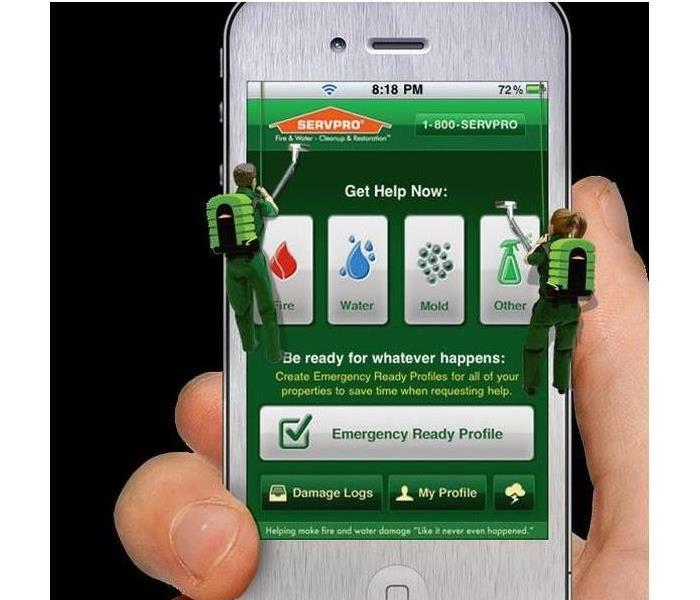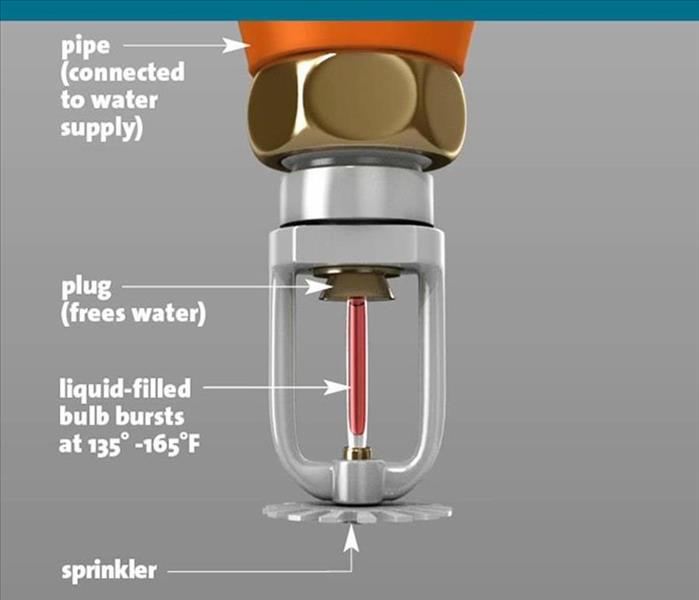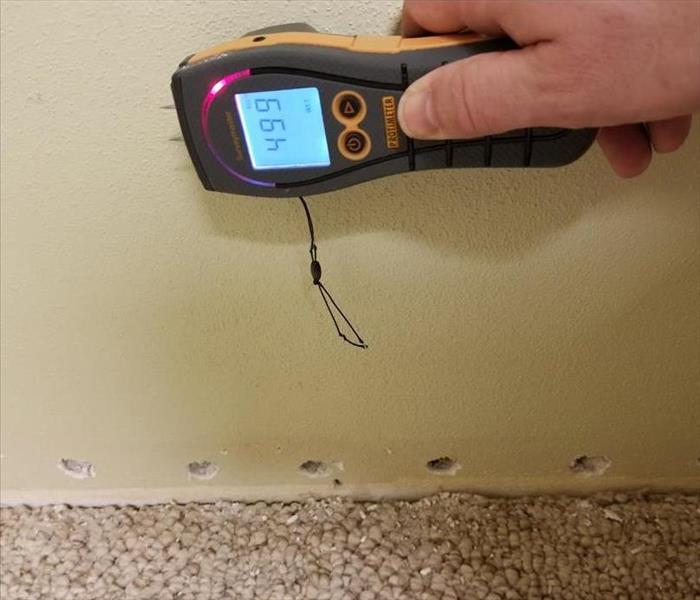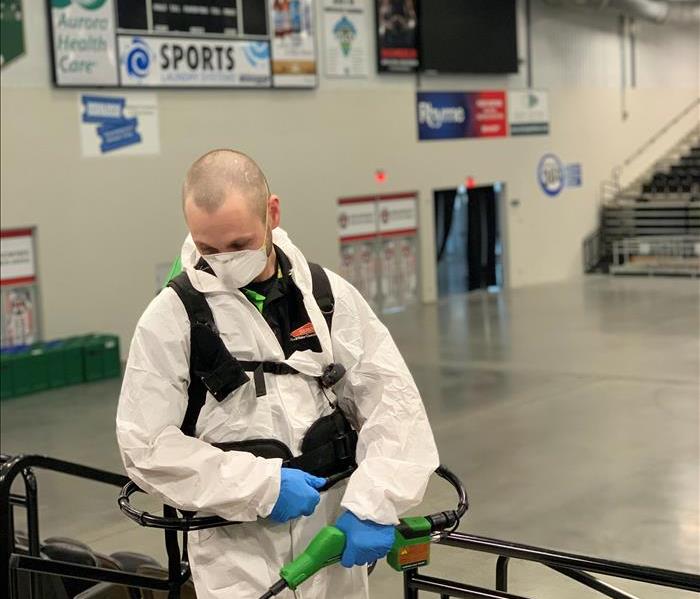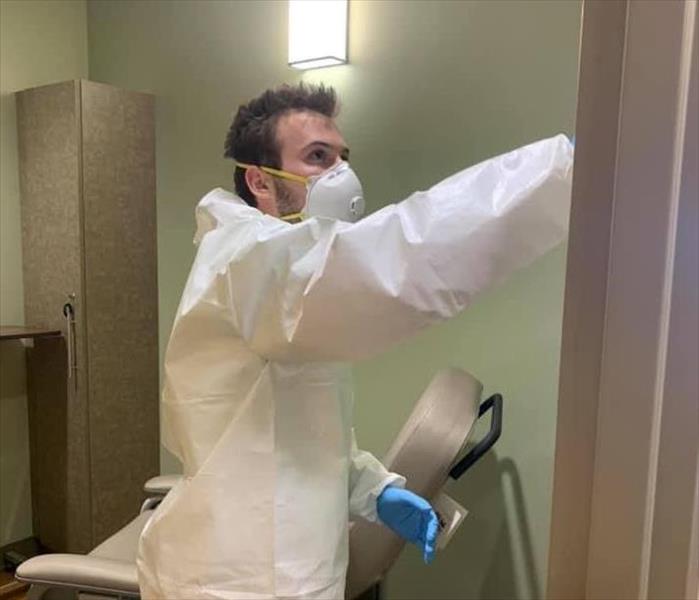Recent Commercial Posts
Renter's Insurance
5/21/2022 (Permalink)
Do you rent the property you live in? If so, do you have renter’s insurance? It’s not uncommon for renters to think they don’t need insurance, especially if the property owner has adequate coverage. Unfortunately, this usually isn’t true, and renter’s find themselves wishing they would have gotten renter’s insurance. Here’s why.
In general, the property owner’s insurance covers damage to the structure, while the renter’s insurance covers what we call “contents”, or the renter’s personal property, things like their furniture, clothing, shoes, electronics, accessories etc…
Let’s look at a specific example. Let’s say you are renting an apartment, and the tenants in the unit above you forgot they left the water running in their tub, it overflows, and water pours into your unit destroying your big screen tv and getting your couch all wet and dirty. The property owner’s insurance will cover the drying and repair of the structure itself, the carpet or flooring, the drywall, the light fixtures etc.. But it will not cover your big screen tv or couch. Those items would be covered under renter’s insurance.
An added benefit of renter's insurance is that because the coverage is for your personal items and not the residence, your belongings are typically covered due to theft and other covered losses when you travel away from home.
Renter’s insurance can also cover expenses like hotel and meals should your residence be uninhabitable from a loss. And it can also provide liability coverage should someone other than you get hurt on your property and attempt to sue you.
If you are a renter, and you don’t have this very important coverage, we highly recommend reaching out to your insurance agent today. A renter’s insurance policy can be as little as $10-$15 a month and is well worth the investment.
Commercial Construction Fire Hazards
5/18/2022 (Permalink)
Commercial properties often have fire safety and prevention systems in place. An effective system will incorporate three main elements: detection, control, and extinguishing. Components of these three things can include but are not limited to: fire & smoke alarms throughout the building, fire extinguishers throughout the building, sprinkler systems, fire/smoke curtains that drop down and contain smoke to certain areas and help hinder spread of the fire.
However, when a commercial building is under construction, these things do not yet exist. This means that commercial buildings under construction can be at increased risk of fire. In addition, according to the U.S. fire Administration, “Buildings under construction or renovation are at their most vulnerable and weakest condition. Accumulation of waste combustibles, limited access, minimal water supply and hazardous operations increase the challenge. Add to this the effects of firefighting operations, increased water weight, weakened metal and support structures, and hidden hot spots, and you have a formula for disaster waiting to happen.” For tips on fire prevention at buildings under renovation or construction visit:
Fire prevention at buildings under renovation or construction (fema.gov)
Commercial Disasters
4/29/2022 (Permalink)
“According to the Association of Records Manager and Administration, about 60% of businesses that experience a major disaster such as a fire close within two years. According to Labor Department statistics, over 40% of all companies that experience a disaster never reopen and more than 25% of those that do reopen close within two years.
With numbers like this, it’s easy to see why hiring a good restoration company that can get your business back up and running as quickly as possible is vital. We have the staff and resources to do that. And we know exactly what you’re feeling and what you need. In March of 2014 we experienced a fire at our own shop when one of our trucks started on fire after being towed back to the shop after hitting a pothole. For over 2 months we operated our business from temporary rented space while our shop and office were being restored. As a result, we truly appreciate what you are experiencing, and our top priority is getting you back to business as usual. Your business depends on it.
ERP's & Hotels
4/12/2022 (Permalink)
Due to their nature, having so many bathrooms per square foot, hotels are at greater risk for water damage than most commercial properties. Each toilet, tub, and sink presents a risk of overflowing, a burst or leaky pipe etc… And when these water damages happen, the scope of the damage can be vast. With many floors/stories, there are plenty of places for the water to travel. As a result, a quick response is essential and can limit damage. To that end, an ERP (Emergency Ready Plan) from SERVPRO can be helpful, especially when a water pipe has burst.
What is an ERP? An ERP is a quick reference of important building and contact information. Information like where the water shut off valves are, the name and contact information for the building’s alarm system management company, and so much more. And your ERP can be loaded as an app on a phone for anyone who might need it, making it conveniently accessible anywhere or anytime, day or night. If your hotel or business would like a personalized ERP at no cost to you, call our office at (920) 832-1110 and ask for one of our sales representatives, Joe or Jamie. They would love to help you out.
ERP's (Emergency Ready Plans) for Businesses
5/4/2021 (Permalink)
What is an ERP (Emergency Ready Plan)?
Whether you own a home or a business, it’s important to be ready for a potential disaster. But it’s particularly important when you own a business. According to a report from the Federal Emergency Management Agency (FEMA), 40% of businesses never reopen following a disaster. And of the ones that do, another 25% fail within one year.
That’s why your business needs an Emergency Ready Plan. While an ERP can’t stop a disaster from happening, it will help your business be ready to handle one.
An ERP is a document that contains the critical information you need in the event of an emergency or disaster. This document can even be loaded as an app on your phone, providing ready access for key employees any day, any time; because disasters don’t just happen during business hours. An ERP will:
- Provide a detailed map of your facility showing where to find important things like water shut-off valves, fire extinguishers and other priority areas. This will allow any employee to get to these areas quickly and efficiently. Prompt response is key in any disaster to help lessen damage. If there is a water main break, the quicker you get to the shut off valve, and stop the flow of water, the less damage there will be. If there is a fire, the quicker you get to a fire extinguisher the better.
- Put all essential phone numbers in one place. All of the essential phone numbers for things like: SERVPRO, the sprinkler system emergency contact, the building owner emergency number, local fire department will now be at any employees finger tips.
- Help employees identify the chain of command and who within the organization has the authority to authorize emergency clean up services to begin. In order for any restoration company to begin work, proper authorization forms must be signed. Any delay in recognizing and reaching the person who has the authority to authorize the work, will result in costly delays to mitigating the damage.
- Be free of charge to your business. Our friendly sales staff would love to do an ERP free of charge for your business. It won’t take much time, and it could save your business.
Be ready with an Emergency Readiness Plan (ERP) from SERVPRO of Appleton and Winnebago County.
Call 920-832-1110 to schedule your FREE plan
Fire Sprinkler Systems in Commercial Buildings
4/7/2021 (Permalink)
When we think of a sprinkler system, we often think of an outdoor system of hydration, watering our lawns in a residential application, or watering a golf course in a commercial application. But buildings can have sprinkler systems as well. Building sprinkler systems protect against fires.
A fire sprinkler system is a water piping system in the ceiling, connected to a water supply, with adequate pressure and flowrate, onto which sprinkler heads are attached. The system discharges water through the sprinkler heads when they detect a rise in temperature adequate to suggest a fire may be present. Historically sprinkler systems were only used in factories and large commercial buildings. Today they have become affordable enough to be used in smaller buildings and even homes.
The National Fire Protection Association (NFPA) is the main organization that sets the standards for fire safety including fire sprinkler system requirements. Some requirements are up to local municipalities. However, according to NFPA 13, all newly constructed commercial buildings that are 5,000 square feet or larger are required to have fire sprinkler systems. In addition, any remodels that add square feet to an existing commercial building so that its footprint is 12,000 square feet or more mandates installation of a fire sprinkler system. NFPA also states that any townhomes with more than two units per building require an automatic fire sprinkler system.
While early systems dispersed water from every head when one head was triggered, systems today only disperse water from the head/heads that detect excessive heat. This helps to minimize water damage to areas of the building not affected by fire. This was one of the primary hesitations people had about sprinkler systems. They felt they were trading fire damage for water damage. As a result, fire sprinkler systems are extensively used today.
Worldwide, over 40 million sprinkler heads are fitted each year. In buildings completely protected by fire sprinkler systems, over 96% of fires were controlled by fire sprinklers alone.
SERVPRO Works to Keep You Open for Business
3/26/2021 (Permalink)
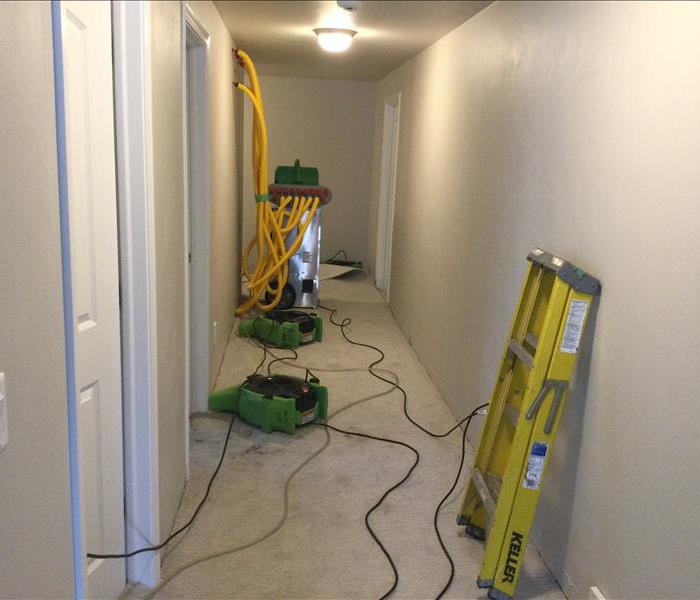 Drying Ceiling in place to reduce disruption and reduce cost.
Drying Ceiling in place to reduce disruption and reduce cost.
When disaster strikes and water floods your home or business, you need it dried quickly and efficiently. Drying things quickly is always important to prevent secondary damage. But it takes on added significance when the damage is at a place of business. Every day that your business is impacted is lost revenue.
Water trapped inside walls and ceilings can be especially troublesome because there’s no easy way to pull moisture through drywall or plaster. Other companies, and remodeling contractors, may be quick to start tearing your home or business apart. This is not only incredibly disruptive, but it can add huge costs to the repair side of the process. Here at SERVPRO we take unique and creative measures to dry your home in the fastest yet least invasive way possible.
In this case we had a wall that had absorbed some water near the ceiling of this hallway. Other companies would have just ripped the drywall out, but we decided to use a spider hosed attachment on one of our fans to inject air into the wall cavity through tiny port holes. This approach saved the homeowner hundreds of dollars in repairs, weeks of time, and they never had to worry about demolition in their home. This is a fantastic example of how we go above and beyond for our customers.
Water Damage from Hydronic Heat Systems
3/25/2021 (Permalink)
Hydronic or water-based radiant heating systems are common in commercial buildings and are even found in residential homes. What are they and why are they used? In a hydronic heating system, water is heated and moved through a system of sealed pipes to radiators throughout the building. Once the heated water is used, it is returned to be reheated via a recirculating system.
Hydronic heat has many advantages. One advantage is the variety of places it can be used. It is even used to heat the Frozen Tundra at Lambeau Field. Green Bay was the first NFL team to heat their field and they have been doing it since 1967. Originally an electric coil system was used. But in 1997 that was replaced with a new, more efficient hydronic system. Buried 6 to 12 inches below the turf is a series of pipes with a combination of warm water and antifreeze running through them. This system prevents the soil and the roots from freezing.
Systems similar to the one at Lambeau Field are used in the cement slabs of commercial buildings. They are even used in basements of residential homes. They can be used to heat swimming pools. The possibilities are many.
Other advantages to hydronic heating:
- Unlike air forced central heating systems there are no airborne particles, providing a totally dust free and allergen free form of heating
- When used to heat the air through radiators or panel radiators, the radiators can be individually adjusted to provide ultimate comfort in each room
- Panel radiators push out natural radiant heat which spreads evenly
But hydronic heat systems are not without their disadvantages. We here in the water restoration business see one of their biggest disadvantages regularly. All pipes run the risk of bursting due to pressure changes or below freezing temperatures. This can happen with plumbing pipes, sprinkler system pipes and hydronic heating pipes. When a pipe in a hydronic heating system bursts, the resulting water damage can be massive if not caught immediately. The system tries to compensate for the loss and keeps pulling more water in to the system. Add to that the loss of heat in the building and an icy mess can be the result. The attached picture of an ice filled bathtub is from a home that experienced such a loss.
Use of Moisture Meters in Commercial Buildings
2/3/2021 (Permalink)
When your home or business is damaged by water, it is important that everything is dried in a timely manner. Timely drying or removal of water damaged materials is essential to prevent secondary damage like mold and rot. But how can property owners tell if things they can’t see or touch are wet? The bigger the property, the more difficult the challenge is as there are more places for the water to run to. That is where SERVPRO of Appleton comes in. To get an accurate picture of your water damage situation, and determine where the water has traveled, and how deep it has gone, we use a variety of moisture meters and even infrared cameras.
There are 3 types of moisture meters: pin, pinless and pin/pinless all in one. In addition, meters can be equipped with a connection option to add accessory probes that can be inserted deeper into a surface for more accurate core or depth readings. They all work on the same basic principle. Moisture conducts electricity. The meters are essentially testing the strength of an electrical connection. Moisture conducts electricity well. The stronger the connection, the wetter the material. Infrared cameras rely on the notion that wet areas not only conduct electricity better, but they also tend to be cooler. Infrared cameras give us an idea where to look for moisture.
We use all types of moisture meters, including probes depending on the surface and situation. Pin meters have two pins on the end of them that are inserted into the surface. These moisture meters can be good for porous materials like carpet or insulation. Pinless meters work well on wood and drywall and other surfaces that we don’t want to put small holes into. Probes are not desirable, as they leave a slightly larger hole, but can become necessary in situations where we need to analyze multiple layers or surfaces.
In the photo you can see that we have removed the baseboard and have drilled holes in the wet drywall. Low profile air movers are placed up to the holes in order to get air circulating behind the wet drywall. We then use moisture meters to determine when the drywall is sufficiently dry. Very often paint will make drywall feel dry to the touch when it is still very wet on the backside. Moisture meters become very important in these situations.
Commercial Building Disinfection
1/12/2021 (Permalink)
The COVID 19 pandemic has been hard on many individuals and businesses. One of the hardest hit businesses is the entertainment industry and their venues, where hundreds, and even thousands of people gather to watch a sporting event, competition, concert or other such event. Some of these venues are publicly owned, while others are privately owned. But no matter who owns them, there are necessary operating costs to avoid damage to the properties, even during a pandemic when their doors are closed to the public. Buildings must still be heated or cooled depending on the climate to avoid things like burst water pipes in cold climates or mold growth in warm and humid climates. Heating and cooling equipment must still be maintained, filters must be changed, and so much more. As a result, these facilities must find a way to get some revenue coming in again in order to survive, especially the private owned venues with no other income source.
This past week we helped one such venue, the Menominee Nation Arena in Oshkosh, disinfect their facility so that they could safely host an event on a limited basis. We disinfected all public areas of the 64,300 square foot arena with SERVPROXIDE. SERVPROXIDE is our own patented disinfectant that kills 99.999% of virus and bacteria cells on hard and soft surfaces. SERVPROXIDE is not a bleach. It’s active ingredient, chlorine dioxid, has a very different chemistry than bleach. Chlorine dioxide is less caustic, safer and gentler than bleach and many other antispetics and antimicrobials. SERVPROXIDE Chlorine or dioxide has been used in defense against Anthrax attacks, to purify drinking water in the aftermath of Hurricane Katrina, and most recently to kill MRSA in schools and hospitals. And now it is being used for the COVID 19 pandemic. Not only is it effective, but it’s safe. It has the lowest toxicity rating given by the EPA. It is safe to use around pets (both cats & dogs), the elderly, as well as children and infants. It is even safe to use around food.
To disinfect the facility, our staff wiped down all high touch hard surfaces like doorknobs, handrails, plumbing fixtures etc..by hand. For soft surfaces and all other areas, we used electrostatic spray to apply the SERVPROXIDE. Electrostatic spray surface cleaning is the process of spraying an electrostatically charged mist onto surfaces and objects. The solution is combined with air and atomized by an electrode inside the sprayer. The resulting spray uniformly covers even the most complex surface.
Electrostatic spray is also more convenient than disinfectant fogging. Fogging requires the space to be evacuated and closed off for extended periods of time during disinfection. Electrostatic spray disinfecting is highly effective and allows the facility far more flexibility.
If you need your commercial building disinfected, give us a call today.
Doing Our Part During the COVID-19 Pandemic
3/26/2020 (Permalink)
The COVID-19 Pandemic is spreading across the globe and the United States. People are anxious and healthcare professionals and our politicians are scrambling to prepare and get ahead of the crisis. Tony Evers, the governor of Wisconsin, has issued a “Safer At Home” Order, which closes all nonessential businesses in the state in an attempt to slow the spread of the virus.
As an emergency services company, we here at SERVPRO of Appleton & Winnebago County are not only open for business, but we are doing our part to assist with the COVID-19 Pandemic. Last week we cleaned and disinfected a 60,000 square foot medical facility that has been sitting vacant since a new facility was built next door. Healthcare officials are now setting up the old facility to be used for testing, triage and overflow.
We are also helping some medical facilities with nightly disinfecting. We are honored to be able to assist our hardworking and brave medical professionals in any way we can.
Business Restoration
2/26/2020 (Permalink)
According to FEMA (Federal Emergency Management Agency), 40% of businesses do not reopen following a disaster such as a fire or flood. And of the businesses that do reopen, another 25% fail within a year.
With numbers like that, it’s easy to see the importance of emergency services and mitigating the loss as quickly and efficiently as possible. We here at SERVPRO of Appleton & Winnebago County have experience on both sides of the equation. Not only are we proud to count some of the biggest and best businesses in the Fox Valley among our customers, but we have experienced our own major disaster.
In March 2014 we experienced a fire at our own office/shop, when a truck parked in our shop caught fire overnight due to damaged wiring. While our structure was still standing, we had extensive fire and smoke damage throughout our shop and attached office. Both our shop and our office were unusable and much of the equipment we use to assist our customers was destroyed. We were completely overwhelmed and filled with despair. But we knew better than anyone that a prompt response was essential. Within less than 12 hours we had rented space and were able to set up operations in temporary spaces, while new equipment was purchased, and the cleanup began. Three months later we were moving back in to our clean and rebuilt home. Six years later we are proud to have not only survived our disaster but continued to grow our business.
If your business experiences a major loss, we are uniquely equipped to help you make it “Like it never even happened,” so that you can count yourself among the success stories.
Flu Season Cleaning
1/9/2020 (Permalink)
According to the Centers for Disease Control and Prevention, the number of flu cases have recently spiked across Wisconsin, putting Wisconsin at a high flu activity level.
If you've had a significant outbreak at your school or office, SERVPRO of Appleton & Winnebago County can help you clean and disinfect your property to prevent the further spread of disease.
Homes and businesses can depend on SERVPRO of Appleton & Winnebago County to clean and sanitize building materials, surfaces and contents following restoration industry standards, using professional cleaning products and EPA-registered cleaners and disinfectants. Our professionals are also equipped to clean your HVAC and duct systems to help provide better air quality and help reduce the risk of circulating harmful contaminants.
Call our office today if we can help you! (920) 832-1110
Commercial Water Damage
7/9/2019 (Permalink)
Last week was very hot and humid in the valley. Many of us welcomed the heat as it was a far stretch from the long, cold winter we recently experienced. It was a difficult winter and many homes and businesses suffered water losses due to the extreme weather we had.
At the end of January, we were called to a furniture store. They experienced a water loss when a pipe on an outside wall, associated with their sprinkler system, froze and burst. Almost 4,000 square feet of showroom became wet as a result. Floors, furniture, area rugs, some walls, all wet.
Our Project Manager Luke quickly arrived on site to assess the situation. In his preliminary investigation he determined that the pipe was still detached or broken, but the water had been shut off at the source. He also determined that power sources were limited. He arranged for an electrician to come in and set up 3 power panels so that our crews would have enough power to run all the equipment (air movers & dehumidifiers) that were necessary to dry out such a large affected space.
Our crews arrived shortly after Luke. While some team members began extracting water from the floors and furniture, other team members began blocking the furniture. This is where we get furniture up on Styrofoam blocks. This not only protects the furniture from sitting in water, but it also protects the flooring from any dyes that may leach out of the wet furniture.
Some drywall was also wet. To dry the drywall, we removed a couple hundred linear feet of baseboard. Approximately 300 holes were drilled in the wall behind the baseboard. This allowed air from our low-profile air movers to get up behind the drywall and properly dry it in place. This is a big savings for the customer versus removing and replacing the wet drywall. Once the walls are dry, the baseboard is put back up and the holes are covered leaving no evidence of the water damage.
In the end we placed approximately 53 air movers, 7 commercial size dehumidifiers, cleaned and saved approximately 400 pieces of furniture and took 28 area rugs back to our shop to be cleaned, deodorized and dried. We had the affected area mostly dried out and back open to customers in less than 3 days.



 24/7 Emergency Service
24/7 Emergency Service


